Disclaimer: This post may contain Amazon affiliate links. Sudachi earns a small percentage from qualifying purchases at no extra cost to you. See disclaimer for more info.
What is Ponzu Sauce?
Ponzu (ポン酢) is a sour condiment unique to Japanese cuisine made with the juice of citrus fruits. Strictly speaking, the term “ponzu” refers to the juice of lemons, limes, bitter oranges, yuzu, sudachi, kabosu, and other citrus fruits to which vinegar is added to enhance the flavor and preserve them.
In addition, citrus juice in which no vinegar is added is sometimes specifically called nama-ponzu (生ポン酢), but it is not generally recognized even in Japan.
In fact, what we Japanese think of when we hear the word “ponzu” is “ponzu shoyu,” a mixture of ponzu and soy sauce, and ponzu shoyu is also referred to together as “ponzu” for short.
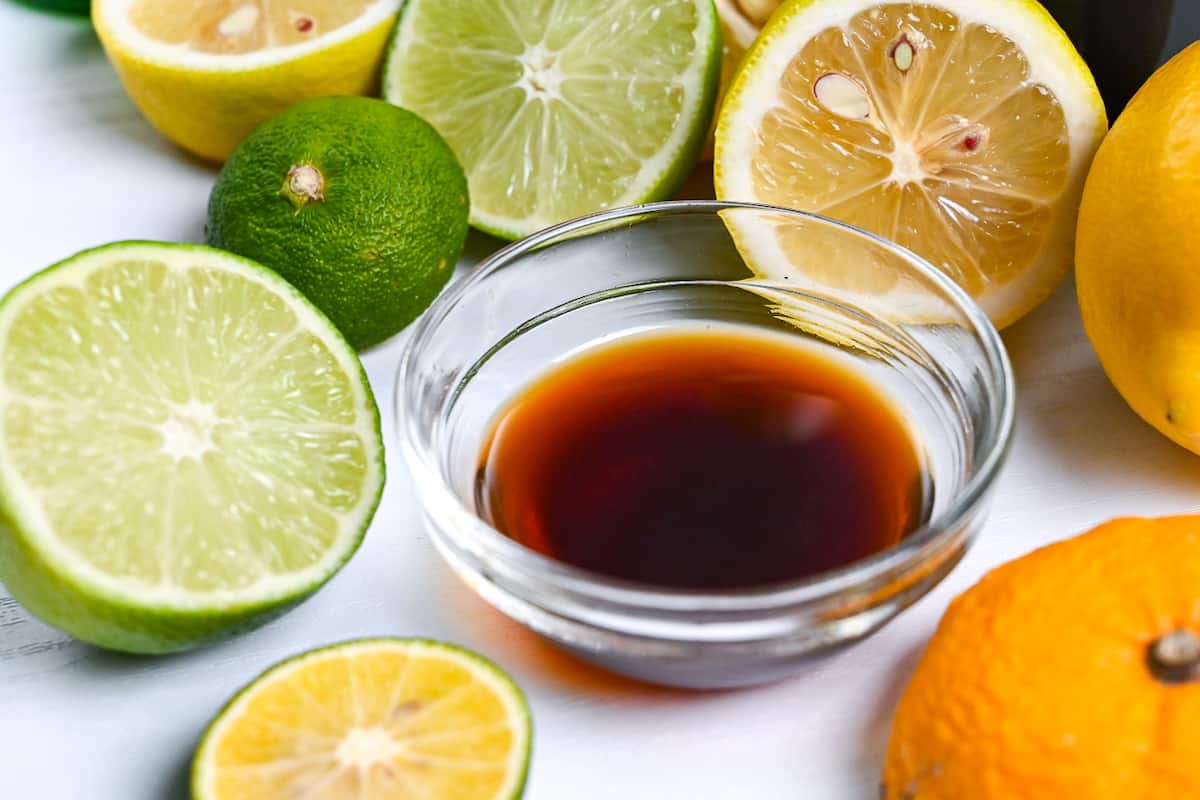

How I Developed This Recipe
Ponzu, with its soy sauce and dashi base complemented by a distinctive citrus flavor, is a uniquely brilliant Japanese condiment. While it’s commonly used in daily life in Japan, most people rely on store-bought versions.
However, making homemade ponzu is surprisingly easy, much simpler than one might think.
This article provides a comprehensive guide on how to create your own ponzu at home, including essential tips and techniques to achieve the perfect blend of flavors!
Kinds of Citrus to Use
The presence of citrus juices is essential in making homemade ponzu. But with a vague term like “citrus”, I’m sure you’re thinking, “Which kind of citrus should I use?”.
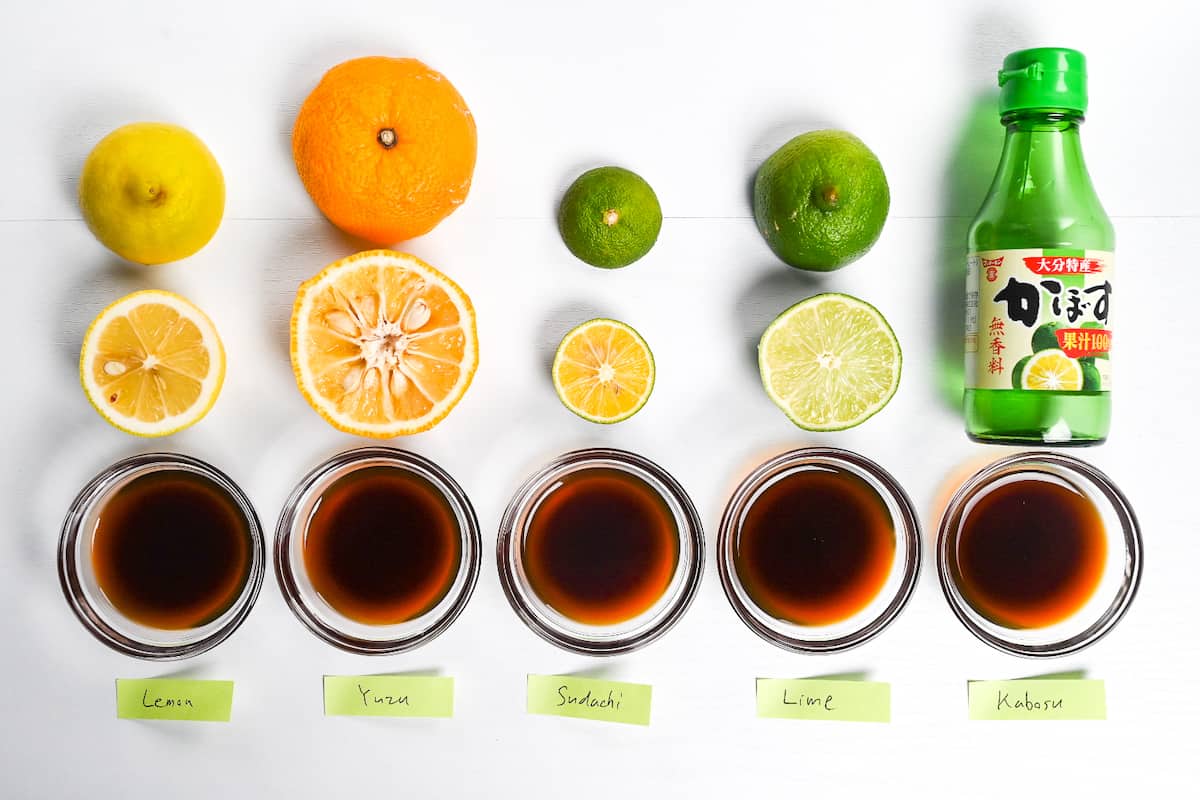
For those who are interested, I have made ponzu using five different types of citrus fruits, ranging from ones that can be found anywhere in the world to rare citrus fruits unique to Japan. The citrus I’ve selected are lemon, yuzu, sudachi, lime, and kabosu.
I will write my impressions of each citrus and compare which one was the best.
Of course, there are other citrus fruits you can try, such as grapefruit, shikuwasa (Citrus depressa), or even some varieties of bitter orange (such as navel or Valencia).
Lemon
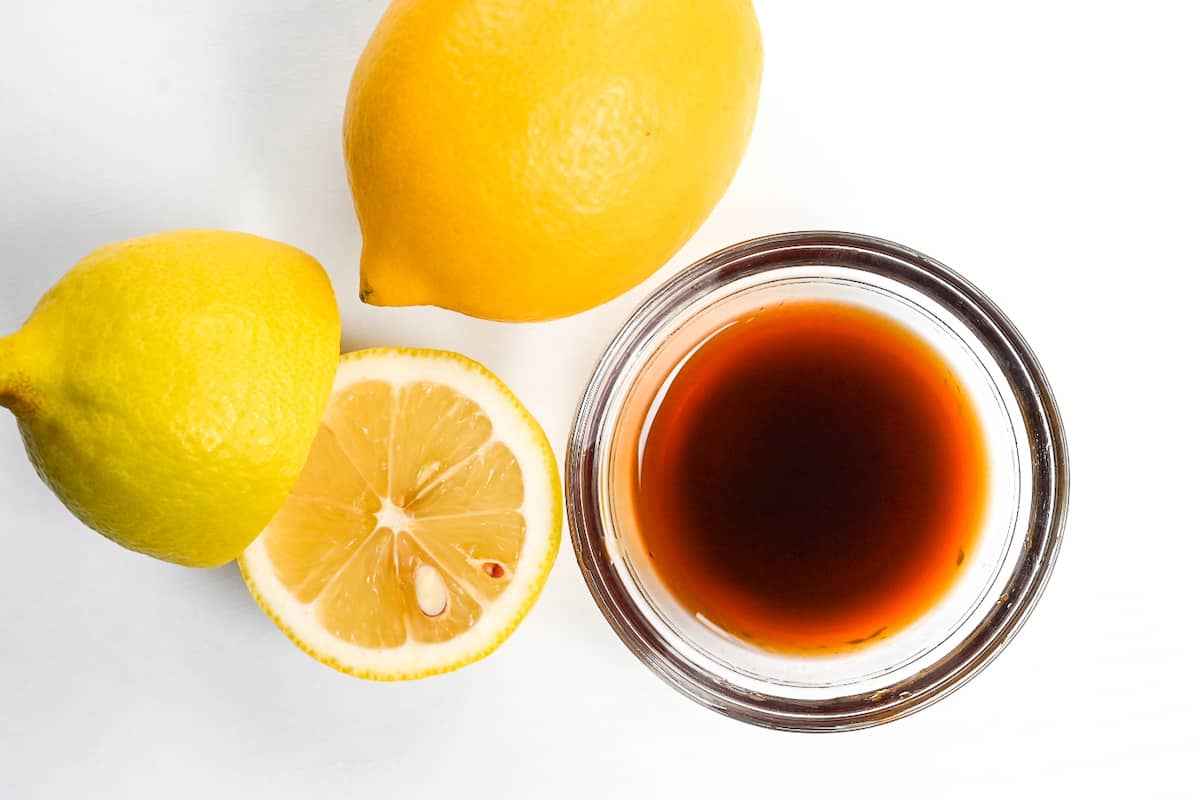
Lemon is the most accessible on the list, a type of citrus fruit that is enjoyed around the world mainly for its acidity and aroma.
You can probably find them at your local supermarket easily, so you might want to start with lemons for simplicity’s sake!
On average, a lemon contains approximately 45ml of juice (depending on size). For my recipe that requires 100ml of citrus juice, I recommend about 2 1/2 to 3 lemons. Alternatively, you can use bottled 100% lemon juice.
I feel that the taste of the lemon juice really highlights the saltiness of the soy sauce, somehow more than the other kinds of citrus I used.
Yuzu
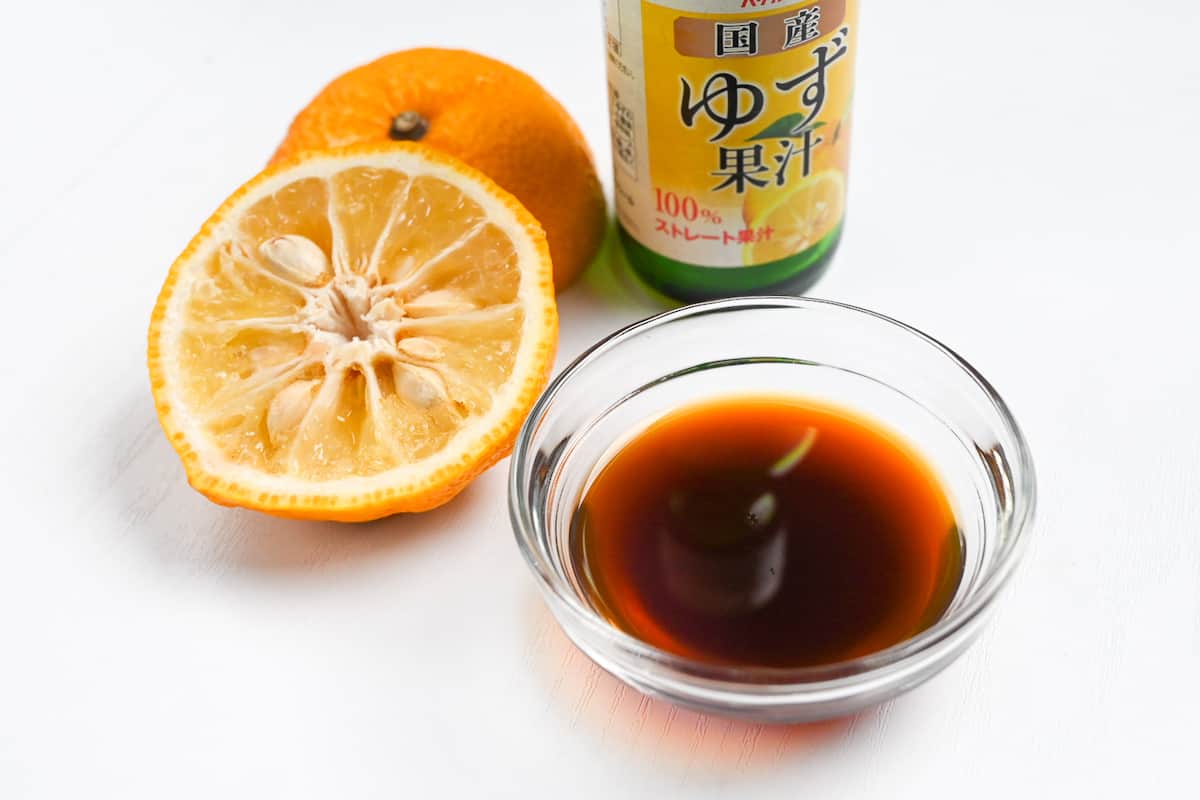
Yuzu is a citrus fruit with a long history, having been cultivated in Japan since the Nara period (710-794). Generally, yuzu is harvested after it has ripened to yellow.
Packaged ponzu sold in Japan is often made from this yuzu, and it is a citrus fruit that goes very well with it.
I have to say that Yuzu was my favorite of the 5. Yuzu has a distinct flavour that works perfectly for ponzu, it’s not really a flavour I can describe well but kind of between lemon and orange. If you can find yuzu where you live, I highly recommend it!
Yuzu is the least “juicy” on the list, it has lots of seeds and 1 fruit only produces about 1 tsp of juice. You will need about 20 yuzu for 100ml of juice! It’s fine (and more economical) to use store-bought yuzu juice (100% straight juice) instead of fresh yuzu. Please check your local Asian supermarket. I checked Amazon, and I couldn’t find any trustworthy brand there. If you live in the UK you can buy yuzu juice from Waitrose or Japan Centre.
Sudachi
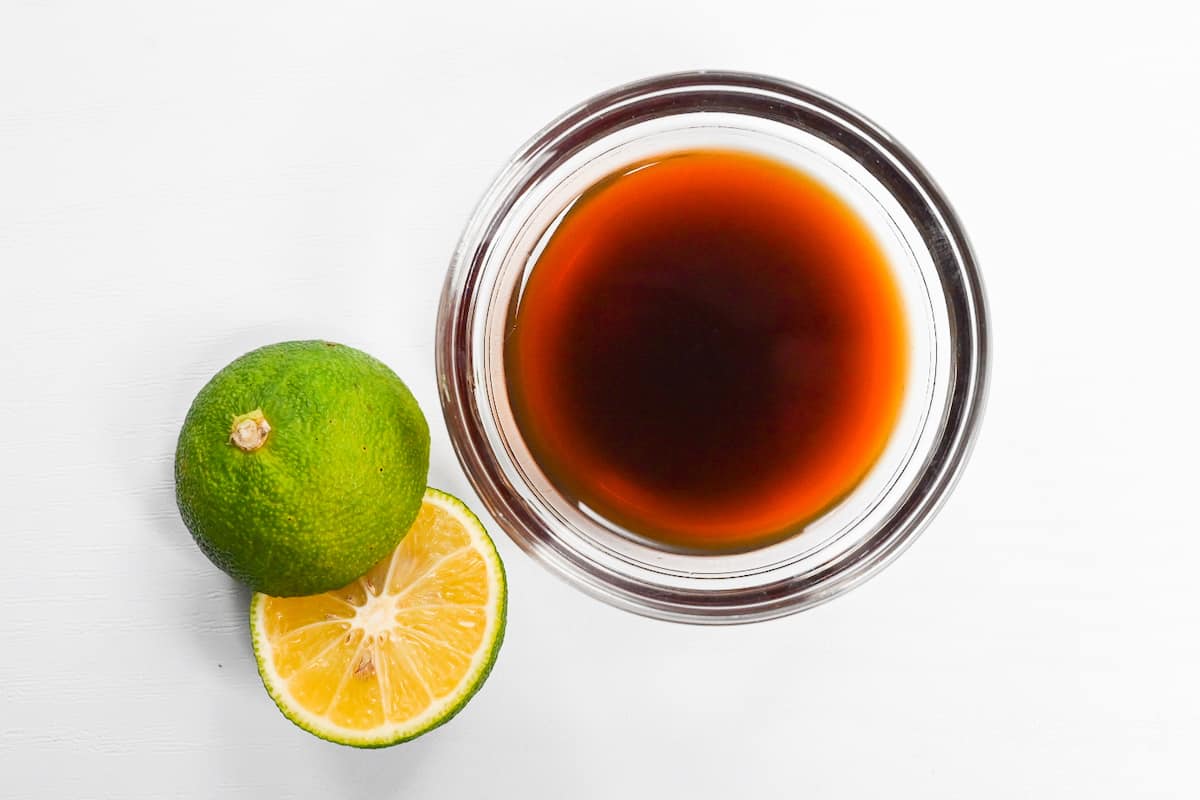
Sudachi, which is also the name of this website, is an aromatic citrus fruit produced mainly in Tokushima Prefecture, Shikoku. Like yuzu and lemon, it is used as a flavor enhancer for fish, tofu, noodles, meat, etc.
It is characterized by its unique, refreshing aroma and crisp acidity, and is sometimes called “green treasure ball” because of its elegance. It was also used as vinegar in cooking in the past, hence the kanji character for it is “酢橘”. I personally think it’s a very elegant combination of kanji.
Despite their small size, sudachi actually contains a decent amount of juice. For 100ml as needed in this recipe, you will only need about 4-5 fresh sudachi fruits. Alternatively, you can buy 100% sudachi juice on Amazon.
As for the sudachi ponzu, I would say that the taste is more sophisticated than lime or kabosu and has a distinctive refreshing flavor which sudachi is famous for.
Lime
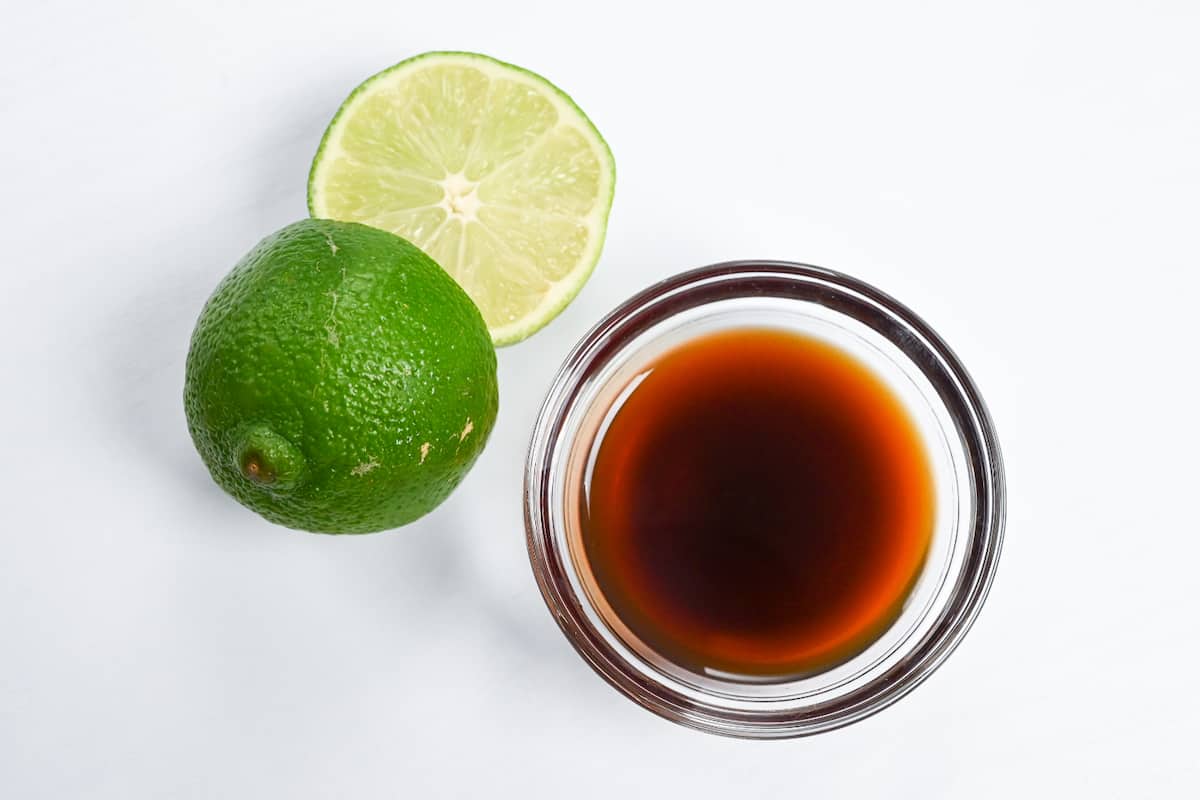
Lime is a citrus fruit of the tangerine family that is believed to originate in the Himalayan region. It is a member of the citrus family like lemon and yuzu, and is often used as a flavoring or condiment rather than eaten raw.
The average lime contains approximately 30ml of juice (depending on size). For my recipe that uses 100ml of citrus juice, you will need about 3 1/2 to 4 fresh limes. Alternatively, you can use bottled 100% lime juice.
It is slightly less acidic than lemon, has a slightly bitter taste, and can be used in ponzu. I think lime ponzu is better than lemon, and I would recommend it if you can’t get hold of Japanese citrus fruits. It works really well!
Kabosu
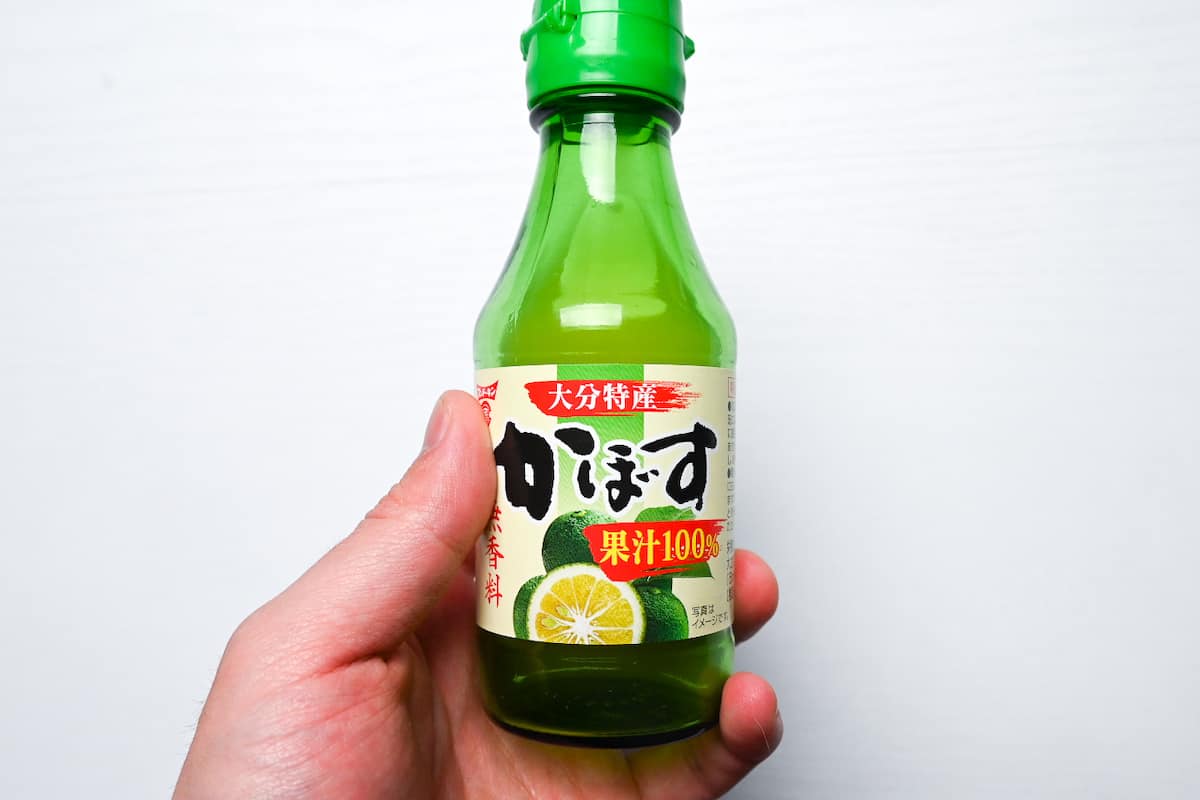
Kabosu is a dark green fruit and part of the tangerine family. It is used to add aroma and acidity to food, and its juice can be made into fruit juice as is or added to alcohol instead of lemon juice. It is said to have originated in the Himalayan region and was introduced to Japan during the Edo period (1603-1868).
Most of the kabosu currently cultivated in Japan is produced in Oita Prefecture. Apparently, it was brought back to Oita from Kyoto by a doctor in the Edo period, and it seems to have been actively cultivated in Oita since then. It is also famous for being used in Oita’s toriten (chicken tempura).
Unfortunately, kabosu was out of season when I created this post, so I used bottled kabosu juice. I will update later when I can use real kabosu.
It has a strong acidity but also contains a moderate sweetness, creating the perfect balance of sweet and sour. It’s safe to say that kabosu is a very elegant citrus. I would say that using it to make ponzu yields a similar result to lime but with a little more elegance.
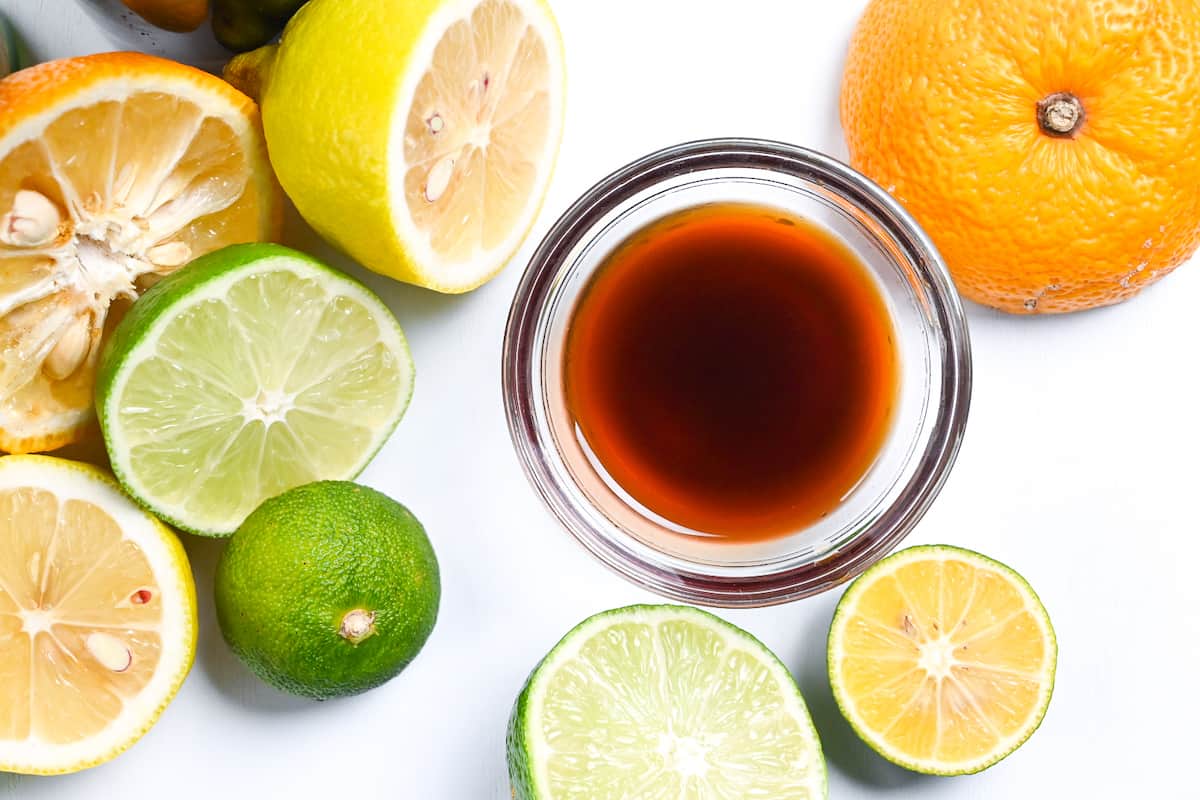
Ingredients & Substitution Ideas
- Mirin: I always go for Hon Mirin (本みりん) like Hinode Hon Mirin for that authentic Japanese flavor. If you’re curious about how it differs from other types, I recommend checking out my mirin guide.
- Citrus Juice: You can pick any citrus juice you like. Earlier in the article, I’ve listed some of my favorite options that work well in this recipe.
- Vinegar: Rice vinegar, specifically the unseasoned type, is my top choice. I wouldn’t suggest other types of vinegar for this recipe. For the best rice vinegar brands, take a look at my article on “20 Most Useful Condiments and Seasonings for Japanese Cooking“.
- Soy Sauce: Kikkoman has always been a reliable and affordable choice, no matter where you are in the world. If you’re looking for more insights or alternatives, my comprehensive soy sauce guide could be helpful.
- Bonito Flakes (Katsuobushi): If you’re preparing this dish for vegetarians or vegans, just leave these out.
- Dried Kelp (Kombu): This adds a deep umami to the dish. To understand more about kelp and its role in cooking, I suggest reading our detailed guide on the topic.
Curious about the exact brands and products that bring my recipes to life? Discover the brands and ingredients behind my recipes at the Sudachi Amazon Storefront. Explore my handpicked pantry essentials and find your next kitchen favorites!
Jump to Full Recipe MeasurementsVisual Walkthrough & Tips
Here are my step-by-step instructions for how to make Authentic Ponzu Sauce at home. For ingredient quantities and simplified instructions, scroll down for the Printable Recipe Card below.
We use mirin to add sweetness and authentic Japanese flavor to the sauce. Mirin contains a small amount of alcohol, and because ponzu can be used raw (for dipping or salad dressings), we need to burn off the alcohol first.
I’m not a big fan of sweet ponzu, so this recipe leans towards a refreshing and sour taste. However, if you prefer a sweeter ponzu like some store-bought ones, you can increase the amount of mirin used here.
To do this, simply heat the mirin in a saucepan and boil it for about 30 seconds to 1 minute.
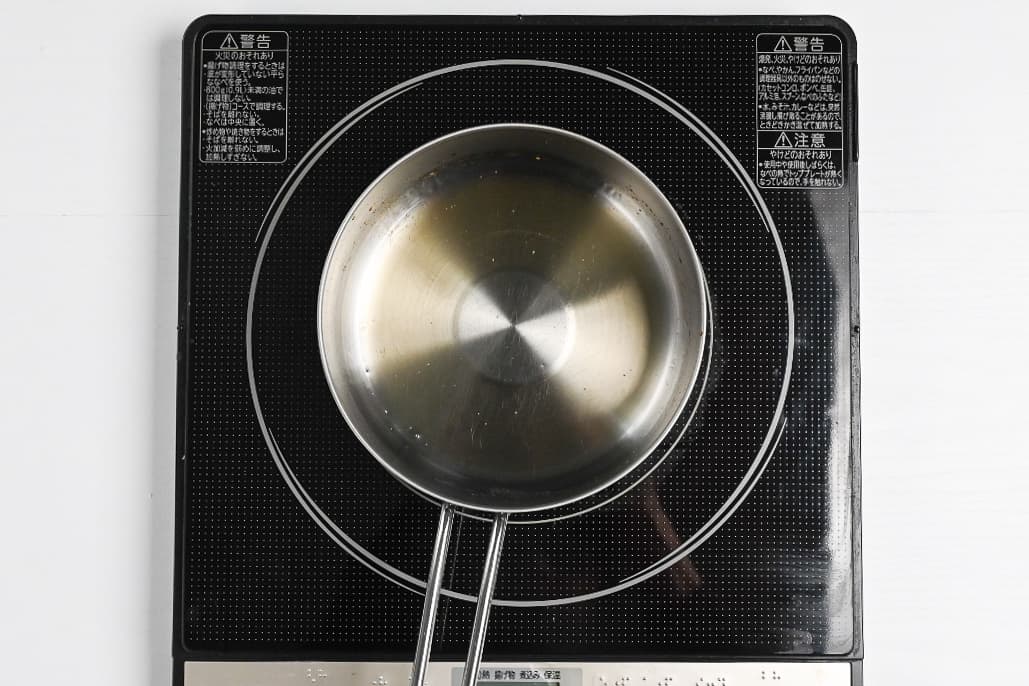
If you can’t use mirin, you can substitute by mixing sugar in hot water until it dissolves. I use 30ml of mirin (2 tbsp) in my recipe, so an ideal substitute would be 1 tsp of sugar mixed with 2 tbsp of water. Increase accordingly if you are doubling or tripling the recipe.
Mix the boiled mirin in a container with citrus juice, vinegar, and soy sauce. Once mixed, add katsuobushi (bonito flakes) and kombu (dried kelp).
If you’re using fresh citrus, make sure to squeeze the juice thoroughly into a measuring jug. It’s okay if some of the pulp is in the juice. There is no need to strain it yet.
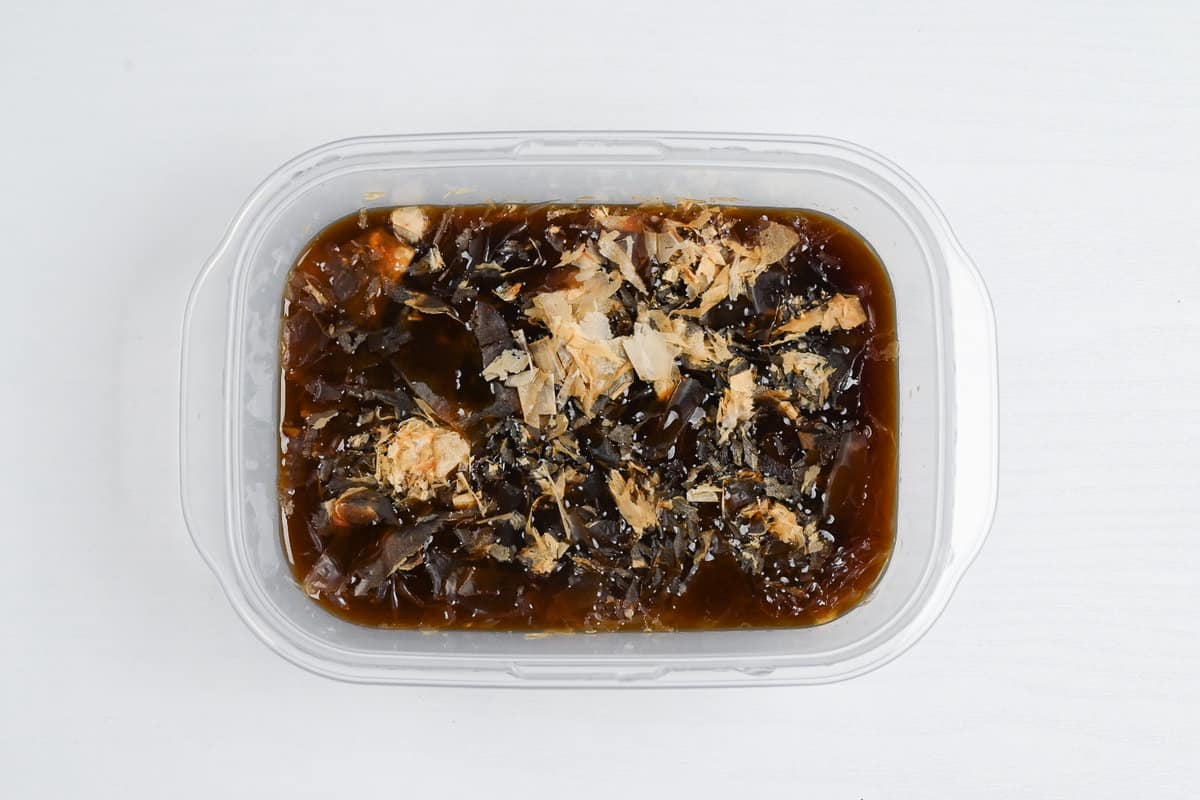
Omit the katsuobushi to make your ponzu suitable for vegetarians and vegans.
Ponzu needs time for the dashi ingredients to release their flavour and allow your ponzu to reach its full potential. I recommend resting it in the fridge for at least 24 hours. If you have time, 2-3 days is optimal.
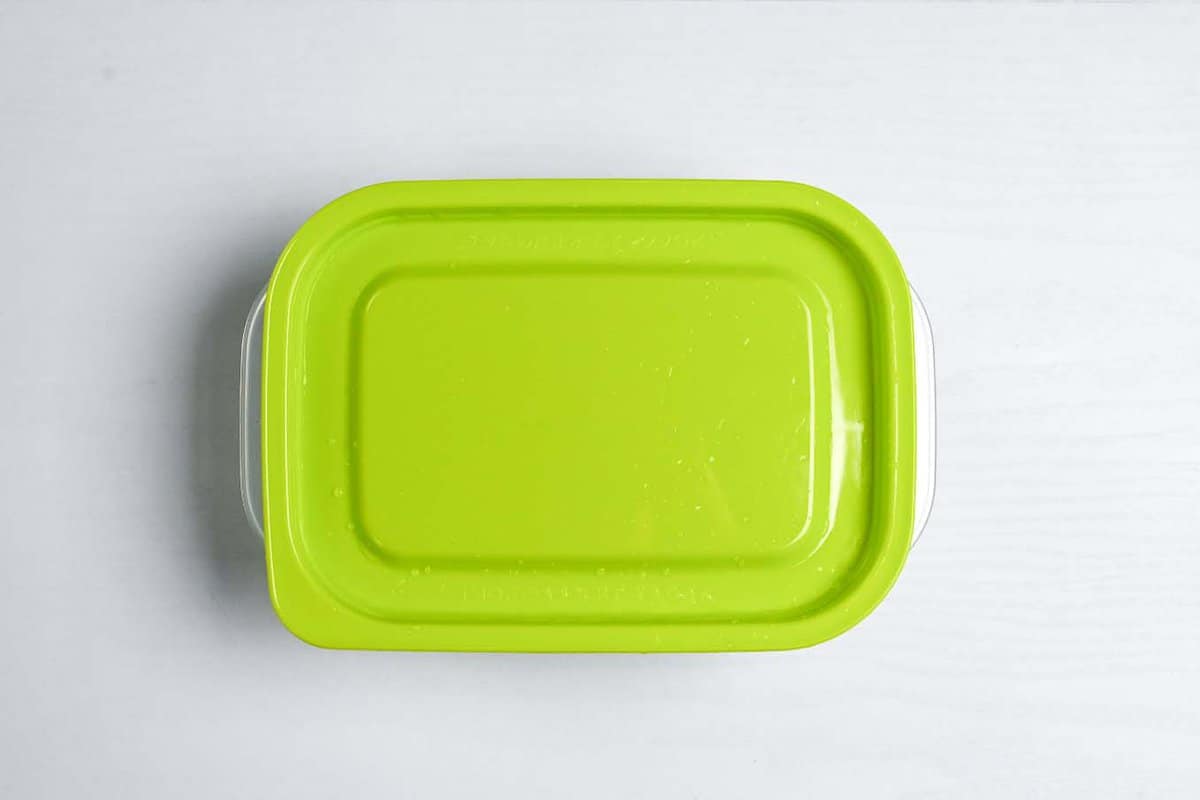
Ponzu is a thin and clear condiment, so you need to remove the dashi ingredients and any pulp that might have been present in the citrus juice. Pour the mixture through a fine mesh sieve to remove them.
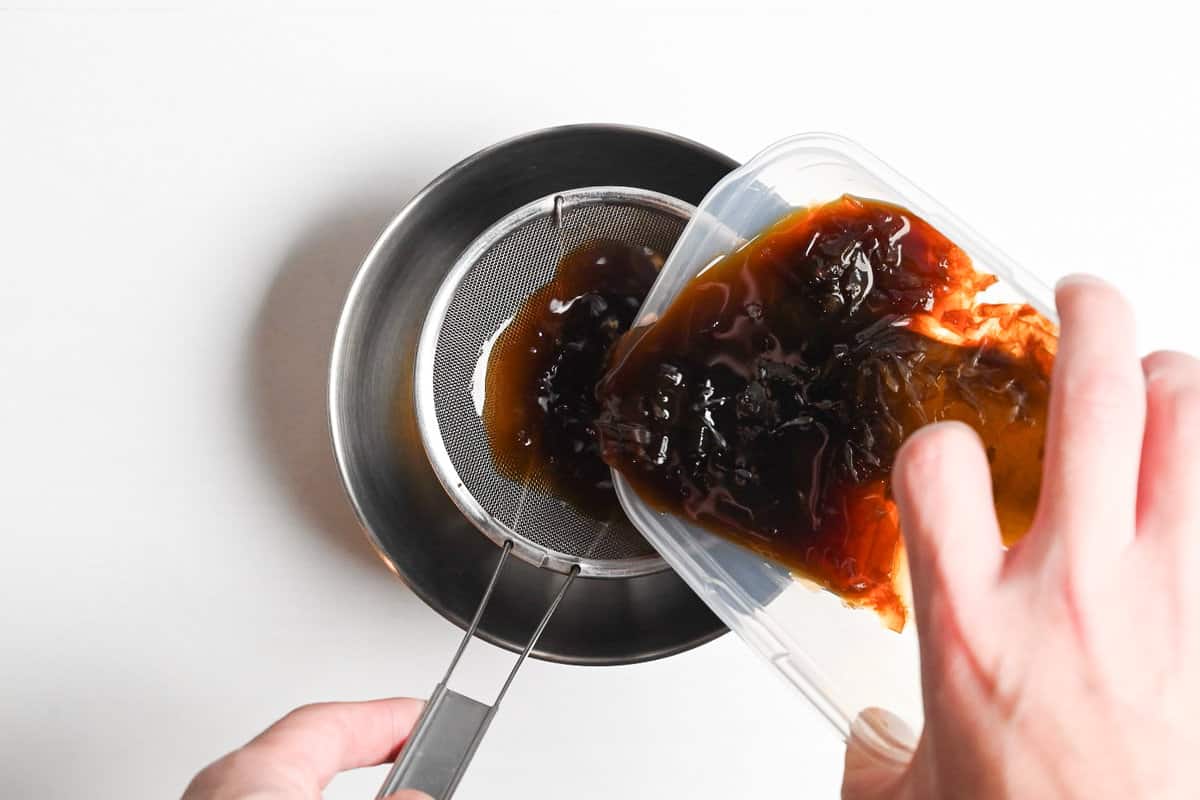
Store in a sterilized airtight jar in the fridge and enjoy ponzu for dipping, cooking, and marinating!
Jump to Full Recipe MeasurementsHow to Store
Ponzu is prone to oxidation, which causes the taste, color, and smell to deteriorate if not stored properly.
For best results, ponzu should be kept in a sterilized air-tight glass container in the fridge, preferably in a vegetable drawer or near the back, to avoid the fluctuating temperature of the opening and closing fridge door.
Opening the container often will also contribute to oxidation, so if you don’t plan to use it often, dividing it into smaller containers and using them one by one will help keep it fresh for longer.
If containers are disinfected and properly sealed, homemade ponzu can be kept in the refrigerator for about 1-3 months. Once opened, check for any change in smell, taste, or appearance and try to use it within 2 weeks.
Alternatively, you can freeze ponzu in an ice cube tray and defrost as you use it, I recommend using up frozen ponzu within 6 months.
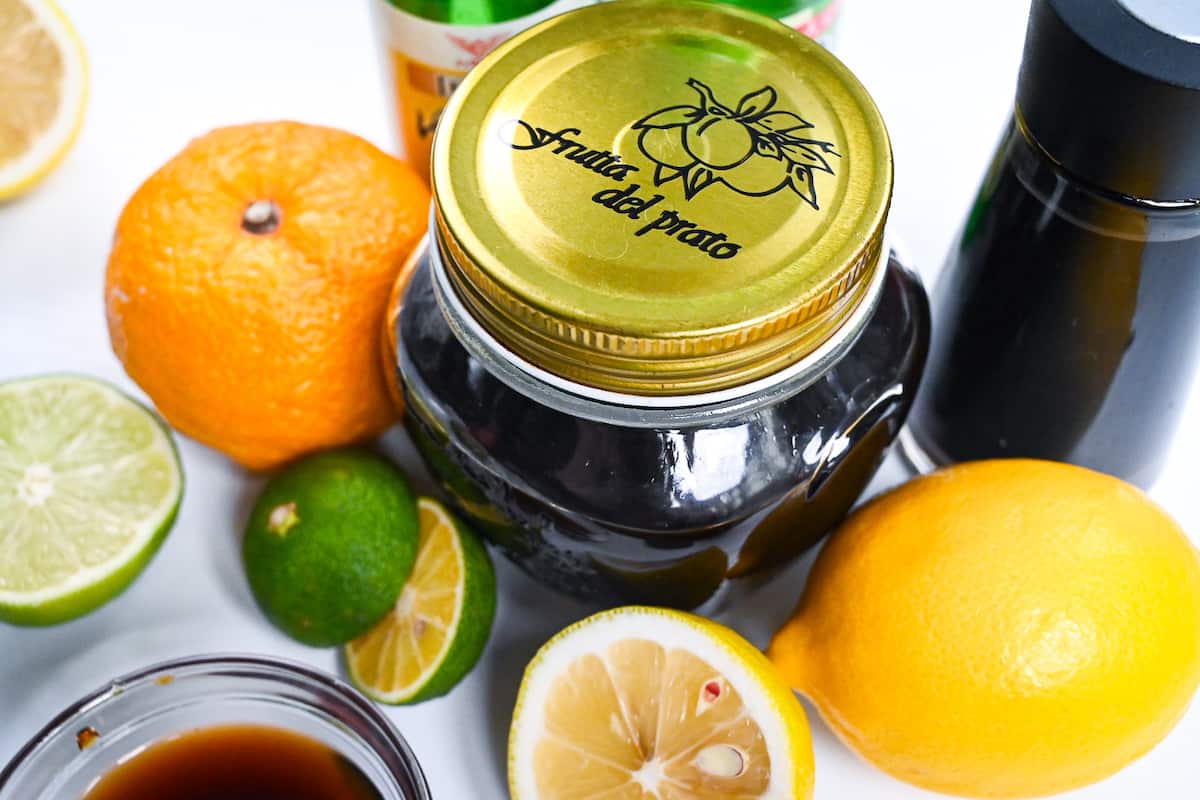
Recipes that You Can Use
In Japanese households, ponzu is a condiment that goes well with various dishes, so much so that it is called an “all-purpose condiment.” It can be used as a dipping sauce, marinade, or drizzle and goes well with meat, fish, or tofu. It can also be used in hotpots or stir-fries.
- Karaage Fried Chicken: Karaage is useally served with lemon wedges, but you can also try it with punchy ponzu sauce. Add grated daikon and spring onion to the sauce for a refreshing twist.
- Chicken Tempura: Chicken tempura (toriten) usually comes with kabosu and ponzu sauce for dipping. You can replace the sauce with ponzu easily. My simple recipe is easy to make and delicious. Give it a try!
- Gyoza: Try using ponzu sauce instead of the typical sour-tasting gyoza dipping sauce for Japanese-style pork gyoza. It’s a great substitute option for those who don’t like vinegar; some people even prefer it over the traditional sauce. The combination is really tasty!
- Shumai: Shumai is commonly dipped in soy sauce and mustard in Japan. You can try ponzu sauce for a refreshing taste!
- Grilled Mackerel: This dish goes well with grated daikon and citrus fruit. Some people add soy sauce, but ponzu sauce is a good alternative.
- Tonkatsu: Use ponzu sauce instead of tonkatsu sauce for a refreshing twist! Grate fresh daikon and pour ponzu over it for a delicious option with tonkatsu.
- Takoyaki: Takoyaki has a popular variation called “negipon” which includes green onion and ponzu sauce. You can make it by adding grated daikon, ponzu sauce, and chopped green onion!
- Hiyayakko: Hiyayakko is a Japanese dish made of cold tofu served with various toppings and sauces. Soy sauce and tsuyu sauce are popular, but some prefer ponzu sauce.
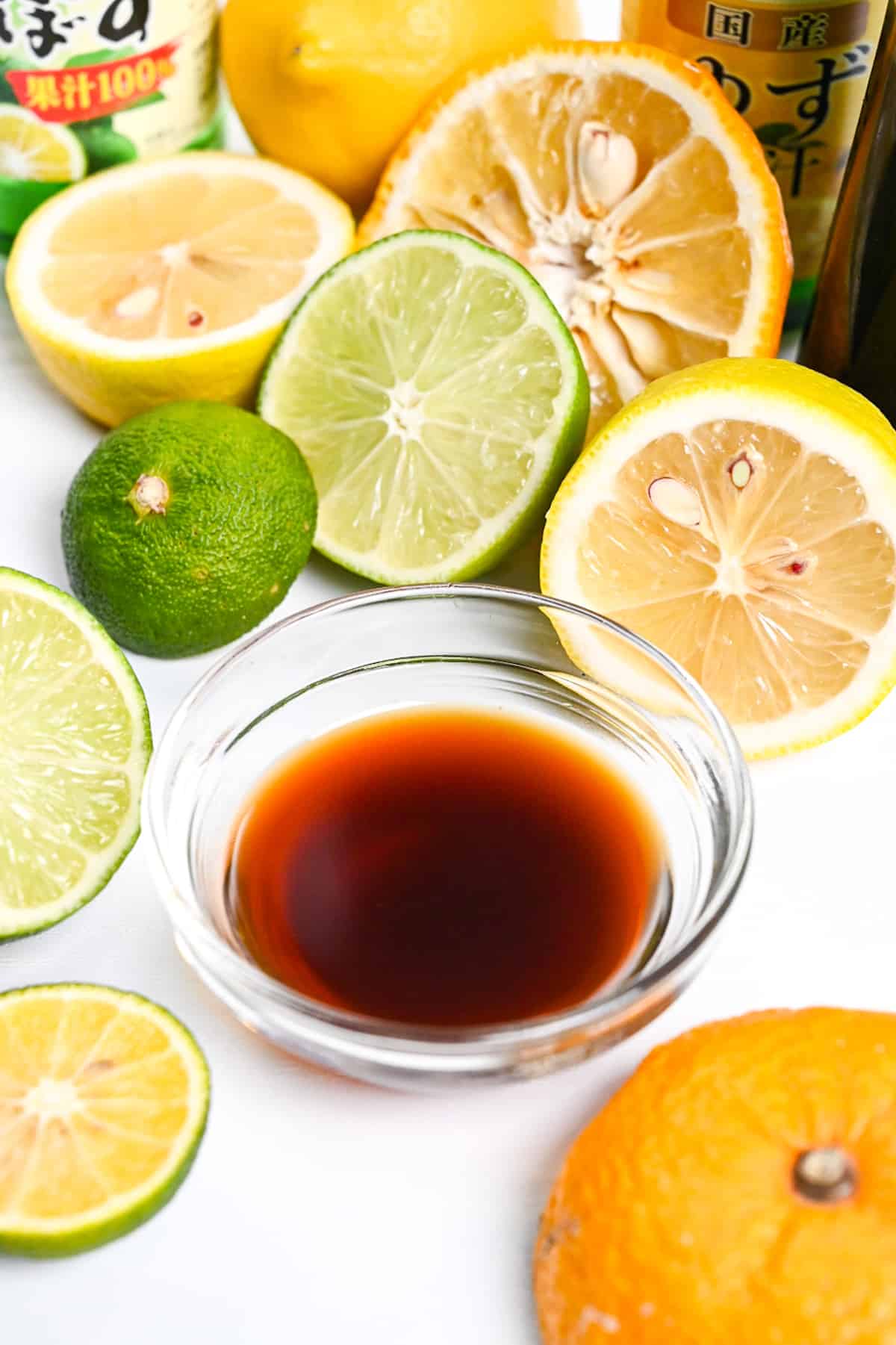
3 Substitution Ideas
As I have explained, homemade ponzu is very easy to make, and I would really like you to try and make it at home. However, if you are really looking for an easy substitute, here are some ideas.
Soy sauce and citrus juice 50:50
It is an extremely simplified version of ponzu. Simply mix half soy sauce and half citrus juice together. However, the disadvantage is that there are no other seasonings in the mixture, so it’s lacking depth compared to real ponzu.
Soy sauce, mirin and citrus juice
For this substitution, mix soy sauce, citrus juice and mirin with a ratio of 2:2:1 respectively. For example, if soy sauce and citrus juice are mixed with 2 tablespoons of each, the amount of mirin would be 1 tablespoon.
The mirin adds some sweetness and umami that helps balance the sour and salty flavors from the soy sauce and citrus juice so it’s a good addition!
If using this substitute, be sure to heat the mirin on the stove for 1-2 minutes to burn off the alcohol. Once this is done, you can mix it with the soy sauce and citrus juice.
Soy sauce, mirin, citrus juice, vinegar, granulated dashi
This is the closest composition to actual ponzu. As before, there are equal parts of soy sauce and citrus juice, half that amount of mirin, a little less vinegar than mirin, and a pinch of granulated dashi.
The important points to keep in mind are to remove the alcohol from the mirin and to dissolve the granulated dashi thoroughly before mixing it. In this case, you can also mix while heating quickly if it’s easier for you.
Nonetheless, homemade ponzu is very easy to make, so please keep reading the article to find out how to make it!
FAQ
The history of ponzu is very interesting. Although it is a condiment unique to Japan, the origin of the word is not Japanese. The name “ponzu” was originally derived from the Dutch word “pons,” which refers to certain alcohol and citrus fruits, and was adopted into the Japanese language.
The Netherlands was the only Western country that traded with Japan during a certain time of the Edo period (1603-1868), when the country was closed to the the rest of the outside world (precisely 1641-1853). At that time, pons were introduced to Japan from the Netherlands as an aperitif, but it eventually became a word for the citrus juice used in pons, and the word became Japanese. It is said that pons were often drunk by Dutch sailors on Dejima Island in Nagasaki.
Incidentally, the kanji for “zu” (酢) in ponzu means “vinegar,” said to be because it had a sour taste like vinegar. Originally, ponzu did not contain vinegar, but the kanji character for “vinegar” was applied to it to mean something sour.
The prototype of today’s ponzu was created again in Dejima, Nagasaki during the Edo period. As a condiment with a Japanese twist on pons, it spread mainly in Kyushu area. However, due to its ease of oxidation, ponzu with soy sauce was considered difficult to handle in the home until the 1950s.
However, as technology evolved, ponzu with soy sauce and other seasonings became widely spread throughout the nation’s dining tables, and is now widely enjoyed as an indispensable seasoning for a variety of dishes. Nowadays, ponzu with soy sauce is also called ponzu.
One of the most widely sold brands of ponzu is “Ajipon” by “Mizkan” which has been on the market since 1964. Due to its popularity, you should be able to find it in your local Asian supermarket. I couldn’t find Ajipon on Amazon, however there is “yuzupon” (yuzu ponzu) from the same brand available here on Amazon US.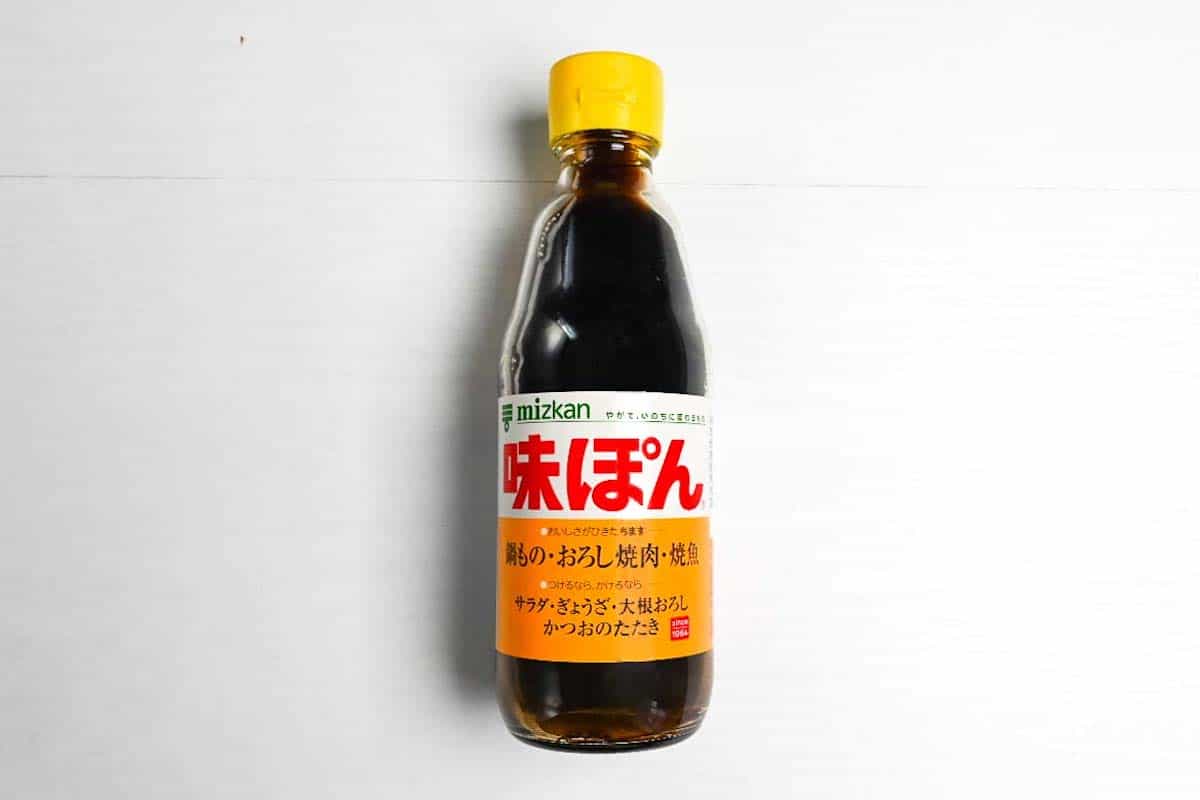
Soy sauce is a condiment made with soybeans and is known for its saltiness and rich umami taste.
Technically speaking, the original meaning of the word “ponzu” refers to a condiment made by adding vinegar to citrus juice. Once soy sauce (and dashi) is added, it was originally called “ponzu shoyu” (ポン酢しょうゆ) or “ponzu soy sauce.” However, these days, the name is simply shortened to “ponzu.”
Ponzu is a condiment with a strong sourness, a hint of sweetness, and depth from dashi in addition to its salty taste contributed by the soy sauce. So, although modern ponzu is soy sauce-based, it is a completely different condiment to soy sauce.
If I were to describe the taste of ponzu in a few words, it could be described as “fruity vinegar.” However, it does not have a strong vinegary smell that goes straight to your nose, and its flavor is somewhere between vinegar and citrus juice, making it most suitable for rich, fatty dishes such as karaage fried chicken and pan fried gyoza.
Unfortunately, ponzu is not gluten-free because it uses soy sauce, which mostly contains wheat. However, homemade ponzu can be made gluten-free using gluten-free soy sauce.
Eel sauce and ponzu sauce are completely different sauces that cannot be replaced each other. Eel sauce is very sweet, rich, and sticky and is specifically used for grilled eel. Ponzu sauce, on the other hand, is thin and sour and used for various purposes. If you want to know how to make eel sauce, please click here for the recipe.
Not at all. Teriyaki is supposed to be quite sweet and savory, but ponzu sauce is a sour condiment.
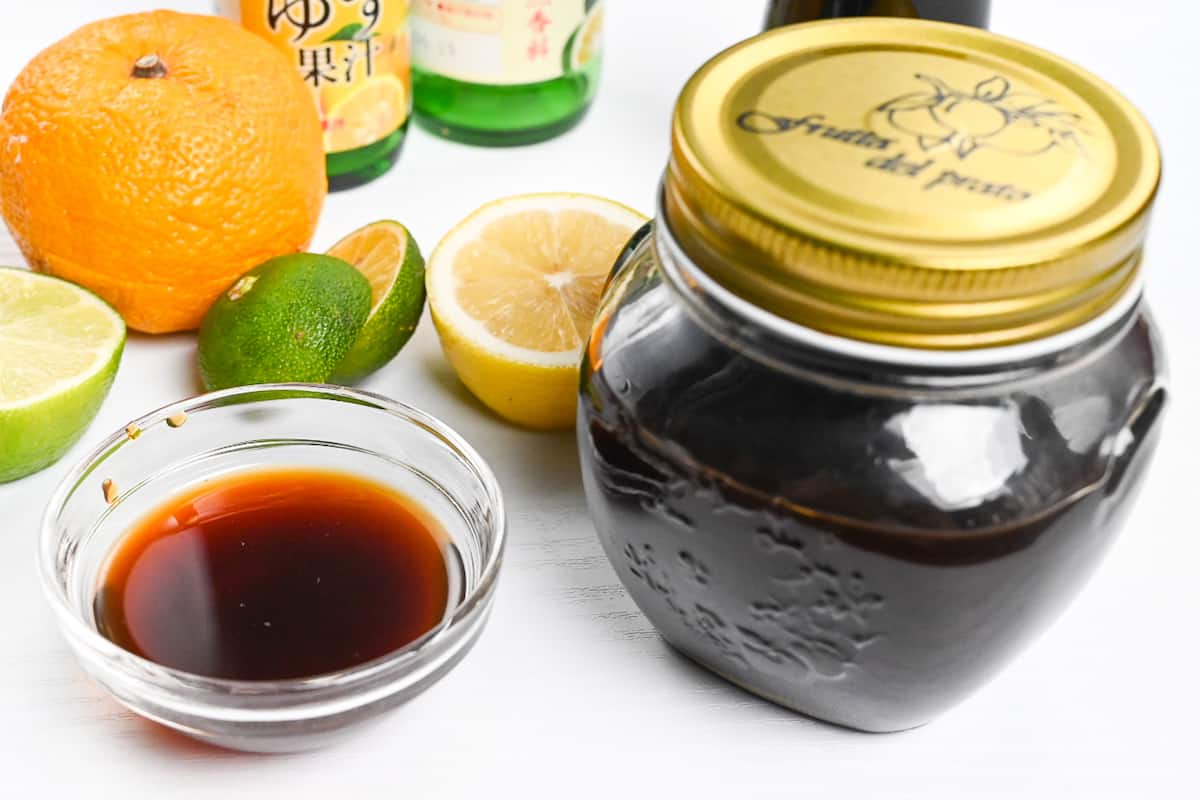
I hope you enjoy this Homemade Ponzu Sauce recipe! If you try it out, I’d really appreciate it if you could spare a moment to let me know what you thought by giving a review and star rating in the comments below. It’s also helpful to share any adjustments you made to the recipe with our other readers. Thank you!
More Japanese Sauce Recipes
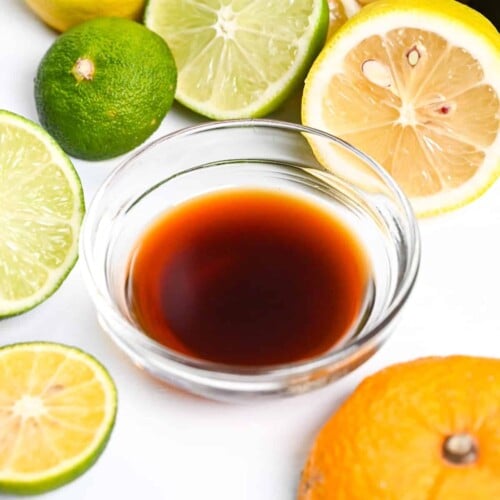
Easy Homemade Ponzu Sauce
Ingredients
- 2 tbsp mirin
- 100 ml citrus juice of your choice
- 1 ½ tbsp rice vinegar
- 125 ml soy sauce
- 5 g bonito flakes (katsuobushi) omit these to make it suitable for vegetarians and vegans
- 10 g dried kelp (kombu) (kombu)
Instructions
- Heat 2 tbsp mirin in a saucepan and allow to bubble for 30 seconds to 1 minute to burn off the alcohol.

- Pour the mirin into a container along with 100 ml citrus juice of your choice, 1 ½ tbsp rice vinegar and 125 ml soy sauce. Mix well, then add 5 g bonito flakes and 10 g dried kelp (kombu) to the container and seal.

- Rest in the fridge for at least 24 hours. (Preferably 2-3 days)

- Strain the ponzu and transfer to a sterilised container.

- Store in the fridge and enjoy!

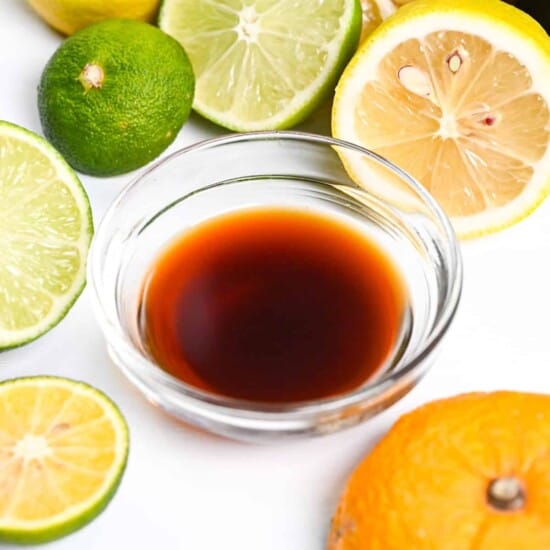



Thank you so much for the explanation. I always wondered why some ponzu brands were labeled “nama”. I also suggest that you might try Meyer lemons. I always have wedges on hand when I use store bought ponzu, but now I will certainly use them when making my own ponzu.
Hi Barbara,
I’m glad you found the article useful!
Meyer lemons are not so easy to come by in Japan, but I think they’d definitely make a delicious ponzu!
If you have time, I would love to hear how your Meyer lemon ponzu turns out.
Hope you enjoy the recipe!
Best wishes, Yuto